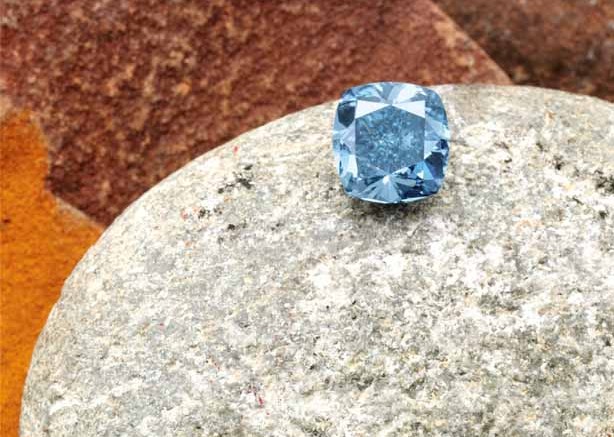The financial crisis of 2008 was the first time that many investors experienced first-hand the worst-case scenarios of investing.
In response to that frightening experience, and the ongoing global financial instabilities, many investors are looking for “safe” places to store their wealth. Although gold is the traditional hard asset safe haven in times of uncertainty, diamonds are now being promoted as a similar type of asset. Even though diamond prices were decimated during the global downturn, falling by more than 50%, as a portable, high-value hard asset, diamonds have a long-term demonstrated history of increasing value and strong supply and demand projections.
“Diamonds have always been considered a secure and safe investment in times of economic distress,” explains Ari Epstein, CEO of Antwerp World Diamond Centre. “This has everything to do with the fact that diamonds are a stable store of value.”
Diamonds don’t yet have widespread investor appeal. But there is a growing demand for large stones, said Chaim Even- Zohar of the diamond consultancy Tacy at this year’s Prospectors and Developers Association of Canada convention in Toronto.
“I can tell you that we see Swiss investment bankers coming to Tel Aviv, they want to buy polished, large goods, they don’t argue about the price,” he said.
The customers are generally wealthy Americans who don’t want to declare the accounts or assets they have in Switzerland, and are happy to put the diamonds in a safe and forget about them. Even-Zohar explained these are new buyers who are not concerned about liquidity.
Options for investing in diamonds are growing. Aside from investing in diamond mining companies, they include purchasing rough or polished diamonds, purchasing diamond jewelry, and investing in diamond funds. The various vehicles for investing in diamonds are being developed by two different communities, says IDEX Magazine correspondent Edahn Golan. “Some of these investment initiatives are coming from within the diamond industry, from diamantaires, and some are coming from the financial community, where they are seen as a positive alternative investment opportunity,” he says.
The vehicles developed by diamantaires are geared toward providing a service to investors — offering to buy and sell diamonds on their behalf. Some of these target wealthy individuals, and others focus on the general public. Some operate as a pool, combining investors’ funds for more purchasing power. They usually use web sites that promote the value of diamonds as an investment, and as a store of value, and encourage potential investors to call in and arrange the purchase of diamonds. These web sites are not always clear on how individual investors would be able to sell their diamonds later at a profit.
California-based Pinnacle Diamonds promotes diamonds as an investment through its web site, targeting all levels of buyers. Investors actually take delivery of diamonds bought through the company, and Pinnacle provides a buyback program for its clients. Pinnacle also uses the term “investment-grade diamonds” to describe their stones. For Pinnacle, investment-grade diamonds are certified by the Gemological Institute of America (GIA) as: F colour or better, VS1 clarity or better, and VG or better rating for cut. Other investment programs also use the term “investment grade,” but the definition is not consistent between programs, nor is the term traditionally used within the diamond industry.
The diamantaires are primarily motivated by the opportunity to bring new capital into their operations. The strong supply and demand projections for diamonds are pushing the prices of rough diamonds higher, supported by growth in the polished markets. If diamantaires can continue to buy and sell diamonds, using investors’ funds, they can grow their business. The inherent danger to investors is: on whose behalf is the diamantaire buying and selling? How do investors ensure that the profit comes to them?
The financial community is also developing diamond investment vehicles, driven by the desire to develop new investment opportunities for their clients, and the fees that can be generated. However, few financial and investment institutions are familiar with the intricacies of the diamond industry.
Adam Shubinsky, general manager of the Diamond Bourse of Canada is seeing a lot of interest from potential investors wanting to do their homework before jumping in.
“We have been meeting regularly with financial analysts from Bay Street, and individual investors requesting information on the diamond market, diamond valuation and diamond supply and demand,” he says.
This is not the first time that diamonds have been promoted as an investment. During the early 1980s, when diamond prices were skyrocketing because of hype over a global shortage of diamonds and because of their appeal as a hard asset in times of high inflation, investors were encouraged to buy polished diamonds. When polished prices crashed almost overnight, many investors and diamond businesses suffered big losses.
More recently, in 2007, Diapason Commodities Management SA announced the creation of Diamond Circle Capital PLC (DIAM-L), a closed–end fund to invest in polished diamonds with a minimum value of US$1 million. After a number of delays, the fund launched in June 2008. The three-year return on the fund is 1.64%, but over the past year it’s been -12.95%.
The concerns with diamonds as an investment are well known: the industry is small (US$10-15 billion), there are problems with consistently valuing diamonds, and there is a lack of transparency on prices and sales. For any investment vehicle to be attractive to investors, it needs to address these concerns. The diamond industry is evolving and continues to grow more open and transparent, but still has a way to go.
This issue of transparency is critical for investors who will be reluctant to part with their money if they cannot determine the price at which their investment wasbought or sold, or track its value over time. While there exist a number of diamond price tracking systems, such as Rapaport, Polished Prices.com and Idex Online, these are aimed primarily at the trade, and not investors or consumers. In fact, there is some reluctance within the trade to providing full price disclosure, for reasons ranging from tax issues, to concerns about profit margins, and a possible threat to the livelihood of diamond traders and middlemen.
Antwerp World Diamond Centre recently announced the creation of an online trading platform that would provide transparent pricing and allow users to track diamond prices over time. “One of the issues that appeared difficult to tackle in the past was the fact that, unlike other products, such as gold, diamonds can’t be standardized so easily,” says Ari Epstein, explaining the reasoning behind the trading platform. “A more transparent pricing, an Antwerp Spot Price, through this global electronic trading platform, could be the driving factor in maximizing the full potential of diamonds as an investment product.”
However, this information will only be accessible to diamond traders. A new ETF proposed by IndexIQ and currently being considered by the U.S. Securities and Exchange Commission, would provide a bit more transparency for investors. If approved the fund would buy and store onecarat diamonds and provide a daily index that could be used to track diamond values.
The ability of an investor or investment vehicle to sell diamonds back into the market and recoup the increased value, while maintaining the value of any stock they still own is another issue that needs to be understood and managed. The entire diamond market is small in the context of global investments, and prices can be impacted by variations in the regular supply of rough and polished diamonds. The supply of rough depends on what is mined out of the ground and changes over time, sometimes significantly as major mines open or close. When Rio Tinto (RTP-N, RIO-L) opened its Argyle diamond mine, in Australia, it substantially increased the global supply of smaller, low-quality rough diamonds. The increased supply of these types of goods contributed significantly to the growth of the Indian diamond cutting industry. Argyle also produces the majority of red/pink diamonds mined each year. As Argyle gets closer to the end of its mine life, the industry will have to adjust to the changing supply of rough and its impact on the profile of available polished diamonds.
Investment vehicles that focus on a smaller segment of the overall diamond market need to be extra cautious in the role they play in the market. Supplies of larger, high-quality diamonds, or of coloured stones is limited to begin with, and if a substantial number of these stones are removed from the market and “stored in funds,” they will artificially reduce supply and drive prices upwards. The funds must carefully manage how their diamonds are sold to ensure that prices do not crash. Without knowledgeable diamond companies managing the fund’s purchases and sales, the potential for price manipulation is a concern. The inherent lack of liquidity in specialized goods may also be an issue for investors.
Diamond Asset Advisors (DAA) believes it has developed an approach that addresses the concerns of potential investors. Under an agreement with Harry Winston Diamond (HD-T, HWD-N) a fund managed by DAA will purchase polished diamonds that meet Harry Winston’s standards, and place the diamonds in Harry Winston retail outlets. When the diamonds are sold to a consumer, ownership is transferred from DAA to Harry Winston. This provides price transparency for the fund, which DAA is aiming to launch by midyear, targeting institutional investors.
“The best selling point for investing in diamonds has been the fact that it is an investment in hard assets,” says the fund’s managing director, Peter Laib. “Investors appreciate that fact, that this is a non-leveraged investment backed by physical assets. However, due to a lack of understanding with the diamond industry, investors have had to become familiar with the very positive supply and demand trends for diamonds, and this has taken longer than we had expected.”
The DAA fund targets a range of diamonds that meet Harry Winston’s standards. Other funds have a different focus. The Novel Diamond Fund I is managed by Hong Kong-based Novel Asset Management, and focuses solely on coloured diamonds. Novel Diamond Fund I began operating on Oct. 1, 2011, and is now closed for investments.
While Alan Landau, CEO for Novel Asset Management won’t reveal the fund’s returns to date, he does say that the response among investors has been positive and that purchases and sales have been “highly encouraging.” The fund sells through the agency of Novel Collection, a coloured diamond manufacturer and trading company with over 80 years experience in the very specialized market of coloured diamonds.
“There is definitely an interest in perceived ‘safe-haven’ investments and alternative non-correlated asset classes. Diamonds fit the bill,” Landau says. “However, institutional investors remain cautious, as diamonds are not well understood, or easily tracked or benchmarked. Consequently, larger investors have wanted to follow the performance of our Novel Diamond Fund I
with an eye to investing in our second fund, Novel Diamond Fund II.”
Attracting more investors would impact the diamond industry in a number of ways. The opportunity to increase the capital available to the industry is substantial. Increased transparency and openness, driven by investors’ requirements will, in the longer term, only benefit the industry and consumers. However, until some of these investment vehicles start to demonstrate viability and returns on par with the promotional rhetoric, caution should be the watchword for industry and investor alike.
— The author is a diamond consultant based in Saskatoon, Sask., and can be reached at mirving@sasktel.net.






Be the first to comment on "Diamonds: as good as gold for investors?"